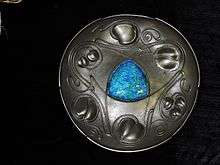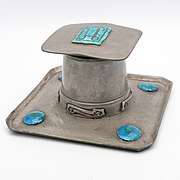Tudric
Tudric is a brand name for pewterware made by W.H. Haseler's of Birmingham for Liberty & Co of London, the chief designer being Archibald Knox, together with David Veazey, Oliver Baker and Rex Silver. The gold and silver ranges were known as Cymric (pro: Koomric). Liberty & Co began producing Tudric in 1899, and continued to the 1930s. The designs use Art Nouveau and Celtic Revival styles, and remain popular with collectors.
Tudric pewter differentiated from other pewters with better quality, it had higher content of silver. Pewter is traditionally known as "the poor man's silver".
Gallery
 'Bollelin' pewter & enamel plate (design 044).
'Bollelin' pewter & enamel plate (design 044). Inkwell with typical hammered finish (design 0404).
Inkwell with typical hammered finish (design 0404). Pewter inkwell with enamel (design 0141)
Pewter inkwell with enamel (design 0141)- Clock (design 0366)
 Vase (design 0323)
Vase (design 0323)
gollark: Oh, so sleep deprivation.
gollark: Presumably that depends on which parts of the brain you target the magnets at.
gollark: Something something transcranial magnetic stimulation?
gollark: I see.
gollark: How would it?
This article is issued from Wikipedia. The text is licensed under Creative Commons - Attribution - Sharealike. Additional terms may apply for the media files.